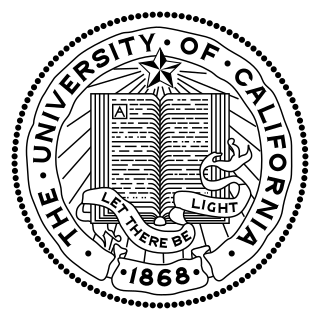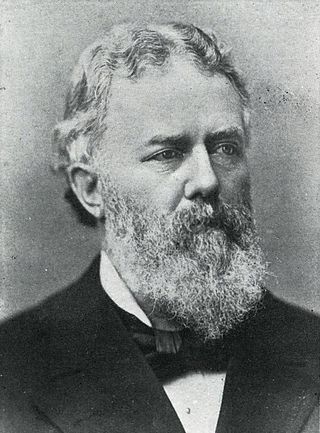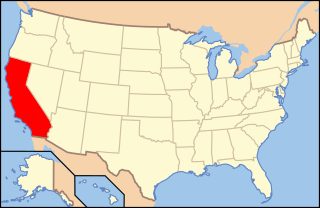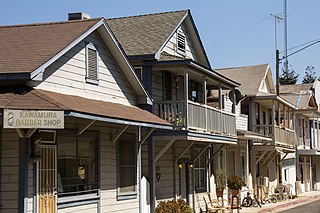
The Chinese Exclusion Act was a United States federal law signed by President Chester A. Arthur on May 6, 1882, prohibiting all immigration of Chinese laborers for 10 years. The law made exceptions for merchants, teachers, students, travelers, and diplomats. The Chinese Exclusion Act was the first and only major U.S. law ever implemented to prevent all members of a specific national group from immigrating to the United States.
Desegregation is the process of ending the separation of two groups, usually referring to races. Desegregation is typically measured by the index of dissimilarity, allowing researchers to determine whether desegregation efforts are having impact on the settlement patterns of various groups. This is most commonly used in reference to the United States. Desegregation was long a focus of the American civil rights movement, both before and after the US Supreme Court's decision in Brown v. Board of Education, particularly desegregation of the school systems and the military. Racial integration of society was a closely related goal.
The Gentlemen's Agreement of 1907 was an informal agreement between the United States of America and the Empire of Japan whereby Japan would not allow further emigration to the United States and the United States would not impose restrictions on Japanese immigrants already present in the country. The goal was to reduce tensions between the two Pacific nations such as those that followed the Pacific Coast race riots of 1907 and the segregation of Japanese students in public schools. The agreement was not a treaty and so was not voted on by the United States Congress. It was superseded by the Immigration Act of 1924.

The University of California College of the Law, San Francisco, is a public law school in San Francisco, California. The law school was formerly known as the University of California, Hastings College of the Law from 1878 to 2023.
Lum v. Rice, 275 U.S. 78 (1927), is a United States Supreme Court case in which the Court held that the exclusion on account of race of a child of Chinese ancestry from a public school did not violate the Fourteenth Amendment to the United States Constitution. The decision effectively approved the exclusion of any minority children from schools reserved for whites.
The Asiatic Exclusion League was an organization formed in the early 20th century in the United States and Canada that aimed to prevent immigration of people of Asian origin.

Mendez, et al v. Westminister [sic] School District of Orange County, et al, 64 F.Supp. 544, aff'd, 161 F.2d 774, was a 1947 federal court case that challenged Mexican remedial schools in four districts in Orange County, California. In its ruling, the United States Court of Appeals for the Ninth Circuit, in an en banc decision, held that the forced segregation of Mexican American students into separate "Mexican schools" was unconstitutional because as US District Court Judge Paul J. McCormick stated, "The evidence clearly shows that Spanish-speaking children are retarded in learning English by lack of exposure to its use because of segregation, and that commingling of the entire student body instills and develops a common cultural attitude among the school children which is imperative for the perpetuation of American institutions and ideals."

The history of Chinese Americans or the history of ethnic Chinese in the United States includes three major waves of Chinese immigration to the United States, beginning in the 19th century. Chinese immigrants in the 19th century worked in the California Gold Rush of the 1850s and the Central Pacific Railroad in the 1860s. They also worked as laborers in Western mines. They suffered racial discrimination at every level of society. The white people were stirred to anger by the "Yellow Peril" rhetoric. Despite provisions for equal treatment of Chinese immigrants in the 1868 Burlingame Treaty between the U.S. and China, political and labor organizations rallied against "cheap Chinese labor".

Matthew Paul Deady was a politician and jurist in the Oregon Territory and the state of Oregon of the United States. He served on the Oregon Supreme Court from 1853 to 1859, at which time he was appointed to the newly created federal court of the state. He served as a United States district judge of the United States District Court for the District of Oregon in Portland, as the sole Judge until his death in 1893. While on the court he presided over the trial that led to the United States Supreme Court decision of Pennoyer v. Neff concerning personal jurisdiction.

Peter Hardeman Burnett was an American politician who served as the first elected Governor of California from December 20, 1849, to January 9, 1851. Burnett was elected Governor almost one year before California's admission to the Union as the 31st state in September 1850.
People from Japan began emigrating to the U.S. in significant numbers following the political, cultural, and social changes stemming from the 1868 Meiji Restoration. Japanese immigration to the Americas started with immigration to Hawaii in the first year of the Meiji period in 1868.
The Lemon Grove Case, commonly known as the Lemon Grove Incident, was the United States' first successful school desegregation case. The incident occurred in 1930 and 1931 in Lemon Grove, California, where the local school board attempted to build a separate school for children of Mexican origin. On March 30, 1931, the Superior Court of San Diego County ruled that the local school board's attempt to segregate 75 Mexican and Mexican American elementary school children was a violation of California state laws because ethnic Mexicans were considered White under the state's Education Code. Although often overlooked in the history of school desegregation, the Lemon Grove Case is increasingly heralded as the first victory over segregative educational practices and as a testimony to the Mexican immigrant parents who effectively utilized the U.S. legal system to protect their children's rights.

California is seen as one of the most liberal states in the U.S. in regard to lesbian, gay, bisexual, transgender (LGBT) rights, which have received nationwide recognition since the 1970s. Same-sex sexual activity has been legal in the state since 1976. Discrimination protections regarding sexual orientation and gender identity or expression were adopted statewide in 2003. Transgender people are also permitted to change their legal gender on official documents without any medical interventions, and mental health providers are prohibited from engaging in conversion therapy on minors.

In the United States, school integration is the process of ending race-based segregation within American public and private schools. Racial segregation in schools existed throughout most of American history and remains an issue in contemporary education. During the Civil Rights Movement school integration became a priority, but since then de facto segregation has again become prevalent.

David Sen-Fu Chiu is an American politician currently serving as the City Attorney of San Francisco. Previously, he served in the California State Assembly as a Democrat representing the 17th Assembly District, which encompasses the eastern half of San Francisco. Chiu was the Chair of the Assembly Housing and Community Development Committee, a position he held from 2016 to 2021, and the former chair of the California Asian & Pacific Islander Legislative Caucus.

Mary Tape (1857–1934) was a desegregation activist who fought for Chinese-Americans' access to education, notably in the case Tape v. Hurley in 1885, in which the Supreme Court of California stated that public schools could not exclude her daughter Mamie Tape for being Chinese-American.

The Walnut Grove Japanese-American Historic District is a 5-acre (2.0 ha) designated U.S. Historic District in Walnut Grove, California. The bulk of Walnut Grove's Japantown was built in 1915–16 following the 1915 fire which destroyed Walnut Grove's Chinatown. Japantown was depopulated during the forced incarceration of Japanese and Japanese-Americans following the issuance of Executive Order 9066 in 1942, and was re-filled by Filipino and Mexican laborers, who took over work in local orchards and farms during the war. Although the original residents returned to Walnut Grove following the end of World War II, most left within a few years, and the district, with some exceptions, to this day retains the original architecture and style dating back to the 1916 reconstruction.

Oriental Public School, founded as The Chinese School, was a public school located in Chinatown, San Francisco, California. It was initially set up in 1859 as a segregated school for schoolchildren of Chinese descent, part of the growing anti-Chinese sentiment in the United States that arose in the late 1800s. The school has been renamed a number of times, most recently in 1998 to the Gordon J. Lau Elementary School in honor of the city's first Chinese-American supervisor.
Ward v. Flood 48 Cal. 49–52 (1874) was the first school segregation case before the California Supreme Court, which established the principle of "separate but equal" schools in California law, 22 years before the United States Supreme Court decided Plessy v. Ferguson. Following Ward v. Flood, litigation over racial segregation in schools in California continued for over a century.














